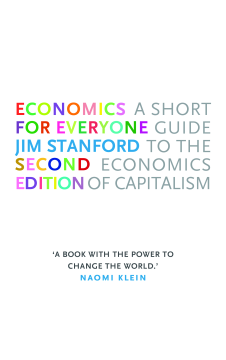
Additional Information
Book Details
Abstract
Economics is too important to be left to the economists. This book provides the information you need to understand how capitalism works (and how it doesn't).
Through clear bite-sized chapters interspersed with illuminating illustrations, this is an antidote to the abstract and ideological way that economics is normally taught and reported on in in media. Key concepts such as finance, competition and wages are explored, and their importance to everyday life is revealed. It answers questions such as 'Do workers need capitalists?', 'Why does capitalism harm the environment?', and 'What really happens on the stock market?'.
The book is supported with a comprehensive set of web-based course materials including videos for popular economics courses.
'Clear, compelling, lively and anger-provoking, all at once'
Robert Pollin, Distinguished Professor of Economics and Co-Director of the Political Economy Research Institute (PERI), University of Massachusetts-Amherst, U.S.A.
'Quite simply the best critical introduction to economics you can find'
Frank Stilwell, Professor Emeritus of Political Economy, University of Sydney, Australia
'Stanford is that rare breed: the teacher who changed your life. He has written a book - both pragmatic and idealistic - with the power to change the world'
Naomi Klein, author of This Changes Everything: Capitalism vs. the Climate and No Logo.
'Helps us understand what the newspapers never explain: how these economic crises are a product of the inequalities and incapacity for social foresight that is capitalism's everyday economics'
Hilary Wainwright, editor of Red Pepper
'Jim Stanford explains what's worth trusting in economics and what's not in an accessible way. Read this book'
Steve Keen, Professor and Head, School of Economics, Politics & History, Kingston University, London, U.K.
Table of Contents
| Section Title | Page | Action | Price |
|---|---|---|---|
| Cover | Cover | ||
| Contents | vii | ||
| Acknowledgements | ix | ||
| Introduction: Why Study Economics? | 1 | ||
| Part One: Preliminaries | 13 | ||
| 1. The Economy and Economics | 15 | ||
| 2. Capitalism | 31 | ||
| 3. Economic History | 41 | ||
| 4. The Politics of Economics | 52 | ||
| Part Two: The Basics of Capitalism: Work, Tools and Profit | 61 | ||
| 5. Work, Production and Value | 63 | ||
| 6. Working with Tools | 79 | ||
| 7. Companies, Owners and Profit | 90 | ||
| 8. Working for a Living | 105 | ||
| 9. Reproduction (for Economists!) | 118 | ||
| 10. Closing the Little Circle | 127 | ||
| Part Three: Capitalism as a System | 135 | ||
| 11. Competition | 137 | ||
| 12. Business Investment | 148 | ||
| 13. Employment and Unemployment | 158 | ||
| 14. Inequality and its Consequences | 168 | ||
| 15. Divide and Conquer | 183 | ||
| 16. Capitalism and the Environment | 195 | ||
| Part Four: The Complexity of Capitalism | 211 | ||
| 17. Money and Banking | 213 | ||
| 18. Inflation, Central Banks, and Monetary Policy | 235 | ||
| 19. Paper Chase: Stock Markets, Financialization and Pensions | 250 | ||
| 20. The Conflicting Personalities of Government | 266 | ||
| 21. Spending and Taxing | 279 | ||
| 22. Globalization | 296 | ||
| 23. Development (and Otherwise) | 312 | ||
| 24. Closing the Big Circle | 324 | ||
| 25. The Ups and Downs of Capitalism | 333 | ||
| 26. Meltdown and Aftermath | 343 | ||
| Part Five: Challenging Capitalism | 359 | ||
| 27. Evaluating Capitalism | 361 | ||
| 28. Improving Capitalism | 371 | ||
| 29. Replacing Capitalism? | 383 | ||
| Conclusion: A Baker's Dozen: Key Things to Remember | 399 | ||
| Index | 403 |
